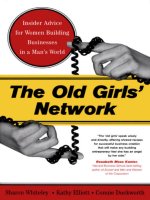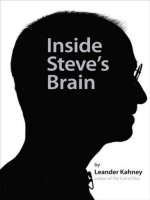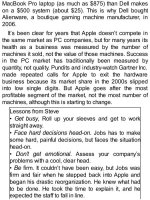Leander Kahney''''s Inside Steve''''s Brain_11 doc
Bạn đang xem bản rút gọn của tài liệu. Xem và tải ngay bản đầy đủ của tài liệu tại đây (192.36 KB, 25 trang )
the Net to synchronize calendar and contact information
among multiple computers. None of this is unique to Apple,
of course, but few companies have embraced the
hardware, software, and services model so
comprehensively or effectively.
The Return of Vertical Integration
Apple’s competitors are starting to wise up to the virtues of
vertical integration, or a whole-systems approach. In August
2006, Nokia acquired Loudeye, a music licensing company
that built several “white label” music stores for other
companies. Nokia bought Loudeye to kickstart its own
iTunes service for its multimedia phones and handsets.
In 2006, Real Networks teamed up with SanDisk, the
number-two player manufacturer in the United States
behind Apple, to pair their hardware and software offerings
à la the iPod. Cutting out the middleman—Microsoft’s
PlaysForSure—the companies instead opted for Real’s
Helix digital rights management, which promised tighter
integration.
Sony, which has decades of hardware expertise but little
or none in software, has set up a software group in
California to coordinate development across the giant’s
disparate product groups.
The group is run by Tim Schaaf, a former Apple
executive, who has been anointed Sony’s “software czar.”
Schaff has been charged with developing a consistent,
distinctive software platform for Sony’s many products. He
will also try to foster collaboration between disparate
product groups, each of which works in its own “silo.” At
Sony, there’s historically been little cross pollination
between isolated product groups, and there’s a lot of
repeated effort but little interoperability.
Sir Howard Stringer, Sony’s first non-Japanese CEO,
reorganized the company and empowered Schaaf’s
software development group to address these problems.
“There’s no question that the iPod was a wakeup call for
Sony,” Sir Howard told CBS’s 60 Minutes. “And the answer
is that Steve Jobs [is] smarter at software than we are.”
Most significantly, Microsoft abandoned its own
PlaysForSure system in favor of the Zune, a combination
player, digital jukebox, and online store.
Although Microsoft pledged to continue to support
PlaysForSure, its decision to go with its new vertically
integrated Zune music system was a clear message that its
horizontal approach had failed.
The Zune and Xbox
The Zune comes out of Microsoft’s Entertainment &
Devices Division, a unique hardware/software shop that
technology journalist Walt Mossberg characterized as a
“small Apple” inside Microsoft.
9
Run by Robbie Bach, a
Microsoft vet who rose through the ranks, the division is
responsible for the Zune music players and Xbox game
consoles. Like Apple, it develops its own hardware and
software, and runs the online stores and community
services that its devices connect to. In spring 2007, the
division unveiled a new product, an interactive, touch-
screen tabletop called Surface.
The division has in its sights Sony and Nintendo, as well
as Apple, and is pursuing a strategy it calls “connected
entertainment”—“new and compelling, branded
entertainment experiences across music, gaming, video
and mobile communications,” according to Microsoft’s
website.
“It’s the idea that your media, whether it’s music, video,
photos, games, whatever—you should have access to that
wherever you are and on whatever device you want—a PC,
an Xbox, a Zune, a phone, whatever works and in whatever
room it works,” Bach told the San Francisco Chronicle. “In
order to do that, Microsoft has taken assets from across
the company and consolidated them in this division
We’re working on the specific areas of video, music,
gaming and mobile, and also trying to work to make all
those things come together in a coherent, logical way.”
10
But to make it work in a coherent, logical way, one
company has to control all the components. In technology
jargon, this is known as “vertical integration.”
When the Chronicle asked Bach to compare Apple’s
and Microsoft’s approaches to consumer devices—
horizontal versus vertical integration—Bach danced about
a little, before acknowledging the strengths of his
competitor’s approach. “In some markets,” he said, “the
benefits of choice and breadth play out successfully. On the
other hand, there [are] other markets and what people are
really looking for is the ease of use of a vertically integrated
solution. And what Apple demonstrated with its iPod is that
a vertically integrated solution could be successful in a
mass way.” Bach admitted that his division is adopting
Apple’s “vertically integrated” model: it is blending
hardware, software, and online services. “The market
showed that’s what consumers want,” he said.
What Consumers Want
These days, more and more technology companies talk not
about products, but “solutions” or “customer experiences.”
Microsoft’s press release announcing the Zune music
player was entitled: “Microsoft to Put Zune Experience in
Consumers’ Hands on Nov 14.” The release emphasized
not the player, but a seamless customer experience,
including connecting to other music lovers online and off,
via the Zune’s WiFi sharing capabilities. It was “an end-to-
end solution for connected entertainment,” Microsoft said.
The market research firm Forrester Research published
a paper in December 2005: “Sell digital experiences, not
products.” Forrester pointed out that consumers spend a
fortune on expensive new toys, like big high-definition TVs,
but then they fail to buy the services or content that bring
them to life, like high-definition cable service. The firm
recommended: “To close this gap, digital industries must
stop selling standalone devices and services and start
delivering digital experiences— products and services
integrated end-to-end under the control of a single
application.”
11
Sound familiar?
In September 2007, at a special press event in San
Francisco, Steve Jobs leapt on stage with a big grin to
introduce the iPod touch: the first finger-controlled iPod.
During the ninety-minute presentation, Jobs unveiled a
cornucopia of Christmas goodies, including a completely
revamped line of iPods and a WiFi music store coming to
thousands of Starbucks coffee shops.
Industry analyst Tim Bajarin, president of Creative
Strategies, who’s followed the tech industry for decades
and has seen it all, is not easily bowled over. Nonetheless,
after Jobs’s presentation as he stood in the aisle talking to
reporters, Bajarin was shaking his head in disbelief.
Ticking off the items one by one—new iPods, the WiFi
music store, the Starbucks partnership—Bajarin noted that
Apple had a full lineup of killer gadgets at every price point
and a comprehensive media delivery system. “I don’t know
how Microsoft and the Zune competes with something like
that,” he said. “The industrial design, the pricing models
that set new rules, the innovation, WiFi.” Now he was
shaking his head more vigorously. “It’s not just Microsoft.
Who out there has the ability to compete with that?”
In the thirty years since founding Apple, Jobs has
remained remarkably consistent. The demand for
excellence, the pursuit of great design, the instinct for
marketing, the insistence on ease of use and compatibility,
all have been there from the get-go. It’s just that they were
the right instincts at the wrong time.
In the early days of the computer industry—the era of
mainframes and centralized data processing centers—
vertical integration was the name of the game. The giants
of the mainframe business, IBM, Honeywell, and Burroughs,
sent in armies of button-down consultants who researched,
designed, and built the systems. They built IBM hardware
and installed IBM software, and then ran, maintained, and
repaired the systems on the customer’s behalf. For
technophobic corporations of the sixties and seventies,
vertical integration worked well enough, but it meant being
locked into one company’s system.
But then the computer industry matured and it
disaggregated. Companies started to specialize. Intel and
National Semiconductor made chips, Compaq and HP
made computers, and Microsoft provided the software. The
industry grew, spurring competition, greater choice, and
ever-falling prices. Customers could pick and choose
hardware and software from different companies. They ran
databases from Oracle on top of hardware from IBM.
Only Apple stuck to its whole-widget guns. Apple
remained the last—and only—vertically integrated
computer company. All the other vertical integrators,
companies that made their own hardware and software—
Commodore, Amiga, and Olivetti— are long gone.
In the early days, controlling the whole widget gave Apple
an advantage in stability and ease of use, but it was soon
erased by the economies of scale that came with the
commoditization of the PC industry. Price and performance
became more important than integration and ease of use,
and Apple came close to extinction in the late nineties as
Microsoft grew to dominance.
But the PC industry is changing. There’s a new era
opening up that has the potential to dwarf the size and
scope of the productivity era of the last thirty years. The era
of digital entertainment has dawned. It’s marked by post-
PC gadgets and communication devices: smartphones
and video players, digital cameras, set top boxes, and Net-
connected game consoles.
The pundits are obsessed with the old Apple-versus-
Microsoft battle for the workplace. But Jobs conceded that
to Microsoft a decade ago. “The roots of Apple were to
build computers for people, not for corporations,” Jobs told
Time. “The world doesn’t need another Dell or Compaq.”
12
Jobs has got his eye on the exploding digital entertainment
market—and the iPod, iPhone, and AppleTV are digital
entertainment devices. In this market, consumers want
devices that are well designed and easy to use, and work
in harmony. Nowadays, hardware companies must get into
software, and vice versa.
Owning the whole widget is why no other company has
been able to build an iPod killer. Most rivals focus on the
hardware—the gadget—but the secret sauce is the
seamless blend of hardware, software, and services.
Now Microsoft has two whole-widget products—the Xbox
and Zune—and the consumer electronics industry is getting
heavily into software. Jobs has stayed the same; the world
is changing around him. “My, how times have changed,”
wrote Walt Mossberg. “Now, with computers, the Web and
consumer electronics all merging and blurring, Apple is
looking more like a role model than an object of pity.”
13
The
things Jobs cares about—design, ease of use, good
advertising—are right in the sweet spot of the new
computer industry.
“Apple’s the only company left in this industry that
designs the whole widget,” Jobs told Time. “Hardware,
software, developer relations, marketing. It turns out that
that, in my opinion, is Apple’s greatest strategic advantage.
We didn’t have a plan, so it looked like this was a
tremendous deficit. But with a plan, it’s Apple’s core
strategic advantage, if you believe that there’s still room for
innovation in this industry, which I do, because Apple can
innovate faster than anyone else.”
14
Jobs was thirty years ahead of his time. The values he
brought to the early PC market—design, marketing, ease
of use—were the wrong values. The growth of the early PC
market was selling to corporations, which valued price
above elegance and standardization over ease of use. But
the growth market is now digital entertainment and home
consumers, who want digital entertainment,
communication, creativity— three areas that play to Jobs’s
strengths. “The great thing is that Apple’s DNA hasn’t
changed,” Jobs said. “The place where Apple has been
standing for the last two decades is exactly where
computer technology and the consumer electronics
markets are converging. So it’s not like we’re having to
cross the river to go somewhere else; the other side of the
river is coming to us.”
15
In a consumer market, design, reliability, simplicity, good
marketing, and elegant packaging are key assets. It’s
coming full circle—the company that does it all is the one
best positioned to lead.
“It seems to take a very unique combination of
technology, talent, business and marketing and luck to
make significant change in our industry,” Steve Jobs told
Rolling Stone in 1994. “It hasn’t happened that often.”
Acknowledgments
Many thanks for help and support from everyone who gave
their time for interviews, shared their expertise and stories,
and provided encouragement and support. The list includes
but is not limited to: Gordon Bell, Warren Berger, Robert
Brunner, Vinnie Chieco, Traci Dauphin, Seth Godin, Evan
Hansen, Nobuyuki Hayashi, Peter Hoddie, Guy Kawasaki,
John Maeda, Geoffrey Moore, Bill Moggridge, Pete
Mortensen, Don Norman, Jim Oliver, Cordell Ratzlaff, Jon
Rubinstein, John Sculley, Adrienne Schultz, Dag Spicer,
Patrick Whitney, and other sources who asked not to be
named.
Special thanks to Ted Weinstein for suggesting the book
and providing constant encouragement.
Notes
Introduction
1 Alan Deutschman, The Second Coming of Steve Jobs
(New York: Broad-way, 2001), pp. 59, 197, 239, 243, 254,
294-95; William L. Simon and Jeffrey S. Young, iCon:
Steve Jobs, The Greatest Second Act in the History of
Business (New York: John Wiley & Sons, 2005), pp. 212,
213, 254.
2 “Steve’s Job: Restart Apple,” by Cathy Booth, Time, Aug.
18, 1997.
(www.time.com/time/magazine/article/0,9171,986849,00.html)
3 “Oh, Yeah, He Also Sells Computers,” by John Markoff,
New York Times, April 25, 2004.
4 Private e-mail from Gordon Bell, November 2007.
5 Smithsonian Institution Oral and Video Histories: “Steve
Jobs,” by David Morrow, April 20, 1995.
(americanhistory.si.edu/ collections/comphist/sj1.html)
6 “Google’s Chief Looks Ahead,” by Jeremy Caplan, Time,
Oct. 2, 2006.
(www.time.com/time/business/article/0,8599,1541446,00.html)
7 “How Big Can Apple Get?” by Brent Schlender, Fortune,
February 21, 2005.
8 Stanford University commencement address by Steve
Jobs, June 12, 2005. (news-
service.stanford.edu/news/2005/june15/ jobs-061505.html)
9 Guy Kawasaki, personal interview, 2006.
10 Gil Amelio with William L. Simon, On the Firing Line:
My 500 Days at Apple (New York: Harper Business,
1999), Preface, p. x.
Chapter 1: Focus: How Saying “No” Saved Apple
1 “Steve Jobs’ Magic Kingdom. How Apple’s demanding
visionary will shake up Disney and the world of
entertainment,” by Peter Burrows and Ronald Grover, with
Heather Green in New York. Business Week. Feb. 6, 2006.
(www.businessweek.com/magazine/content/06_06/b3970001.htm)
2 “IBM had a 10.8 percent market share; Apple 9.4
percent; and Compaq Computer 8.1 percent, according to
market research firm IDC,” New York Times, Jan. 26,
1995, Vol. 144, No. 49953.
3 “Apple’s Executive Mac Math: The Greater the Lows, the
Greater the Salary,” by Denise Carreso, New York Times,
July 14, 1997.
4 Amelio with Simon, On the Firing Line, p. 192.
5 Ibid., p. 193.
6 Ibid., p. 199.
7 “Steve’s Job: Restart Apple.”
8 In the first quarter of 1996, Apple recorded a loss of $740
million.
9 Amelio with Simon, On the Firing Line, p. 200.
10 Ibid., p. 198.
11 Apple’s World Wide Developers Conference, May 11,
1998.
12 Don Norman, personal interview, October 2006.
13 Deutschman, The Second Coming of Steve Jobs, p.
256.
14 Jim Oliver, personal interview, October 2006.
15 Oliver said he was later amazed that Apple’s revenues
did indeed bottom out at about $5.4 billion.
16 “Steve’s Job: Restart Apple.”
17 Ibid.
18 Ibid.
19 “Steve Jobs’ Magic Kingdom.”
20 Ibid.
21 “The Three Faces of Steve. In this exclusive, personal
conversation, Apple’s CEO reflects on the turnaround, and
on how a wunderkind became an old pro,” by Brent
Schlender and Steve Jobs, Fortune, Nov. 9, 1998.
(money.cnn.com/magazines/fortune/fortune_archive/1998/11/09/250880/index.htm)
22 “Steve’s Job: Restart Apple.”
23 Jim Oliver, personal interview, October 2006.
24 Seybold San Francisco/Publishing ’98, Web Publishing
Conference, special keynote: Steve Jobs, Aug. 31, 1998.
25 “Steve Jobs on Apple’s Resurgence: ‘Not a One-Man
Show’,” by Andy Reinhart, Business Week Online, May 12,
1998.
(.www.businessweek.com/bwdaily/dnflash/may1998/nf80512d.htm)
26 “Gates Takes a Swipe at iMac,” CNET News.com staff,
July 26, 1999. (www.news.com/Gates-takes-a-swipe-at-
iMac/2100-1001_3-229037.html)
27 “Thinking Too Different,” by Hiawatha Bray, Boston
Globe, May 14, 1998.
28 “Stringer: Content Drives Digitization,” by Georg Szalai,
The HollywoodReporter, Nov. 9, 2007.
(www.hollywoodreporter.com/hr/content_display/business/news/e3idd293825dd51c45cff
4f1036c8398c0e)
29 “The Music Man: Apple CEO Steve Jobs Talks About
the Success of iTunes, Mac’s Future, Movie Piracy,” by
Walter S. Mossberg, Wall Street Journal, June 14, 2004.
(online.wsj.com/article_email/SB108716565680435835-
IRjfYNolaV3nZyqaHmHcKmGm4.html)
30 Ibid.
31 “Steve Jobs at 44,” by Michael Krantz and Steve Jobs,
Time, Oct. 10, 1999.
32 IDC, Top 5 Vendors, United States PC Shipments,
Third Quarter 2007.
(www.idc.com/getdoc.jsp;jsessionid=Z53BVCY1DTP
R2CQJAFICFGAKBEAUMIWD?
containerId=prUS20914007)
Chapter 2: Despotism: Apple’s One-Man Focus
Group
1 Cordell Ratzlaff, personal interview, September 2006.
2 Peter Hoddie, personal interview, September 2006.
3 “Steve Jobs: The Rolling Stone Interview. He changed the
computer industry. Now he’s after the music business,” by
Jeff Goodell, posted Dec. 3, 2003.
(www.rollingstone.com/news/
story/5939600/steve_jobs_the_rolling_stone_interview)
4 “The Guts of a New Machine,” by Rob Walker, New York
T i m e s Magazine, Nov. 30, 2003.
(www.nytimes.com/2003/11/30/ magazine/30IPOD.html)
5 Ibid.
6 John Sculley, personal interview, December 2007.
7 Ibid.
8 Patrick Whitney, personal interview, October 2006.
9 “Steve Jobs on Apple’s Resurgence.”
10 Dag Spicer, personal Interview, October 2006.
11 Guy Kawasaki, personal interview, October 2006.
Chapter 3: Perfectionism: Product Design and the
Pursuit of Excellence
1 “Steve’s Two Jobs,” by Michael Krantz, Time, Oct. 10,
1999. (http://
www.time.com/time/magazine/article/0,9171,32209-
2,00.html)
2 Paul Kunkel and Rick English, Apple Design: The Work
of the Apple Industrial Design Group (Watson-Guptill
Publications, 1997), p. 22.
3 Ibid., p. 13.
4 Ibid.
5 Ibid., p. 15.
6 Ibid., pp. 28-37.
7 Ibid., p. 26.
8 Andy Hertzfeld, Revolution in the Valley (Sebastapol,
Calif.: O’Reilly Media, 2004), p. 30.
9 “Signing Party,” Andy Hertzfeld, Folklore.org.
(.www.folklore.org/StoryView.py?
project=Macintosh&story=Signing_
Party.txt&showcomments=1)
10 Quoted in Steven Levy, Insanely Great: The Life and
Times of Macintosh, the Computer That Changed
Everything (New York: Penguin, 1994), p. 186.
11 “Why We Buy: Interview with Jonathan Ive,” by Charles
F i s hm a n, Fast Company, Oct. 1999, p. 282.
(www.fastcompany.com/ magazine/29/buy.html)
12 Ibid.
13 “PC Board Esthetics,” by Andy Hertzfeld, Folklore.org
(.www.folklore.org/StoryView.py?
project=Macintosh&story=PC_ Board_Esthetics.txt)
14 John Sculley, Odyssey: Pepsi to Apple: The Journey of
a Marketing Impresario(New York: HarperCollins, 1987), p.
154.
15 John Sculley, personal interview, December 2007.
16 “The Guru: Steve Jobs,” by Charles Arthur, The
Independent (London, UK), Oct. 29, 2005.
17 “The Wired Interview: Steve Jobs: The Next Insanely
Great Thing,” by Gary Wolf, Wired, Issue 4.02, Feb. 1996.
18 “The Observer Profile: Father of Invention,” by John
Arlidge, The Observer (UK), Dec. 21, 2003.
19 Ibid.
20 Design Museum interview, March 29, 2007. (http://www
.designmuseum.org/design/jonathan-ive)
21 Ibid.
22 “An Evening into Former Apple Industrial Designers,”
public lecture, June 4, 2007, Computer History Museum,
Mountain View, California.
23 Ibid.
24 “Radical Craft: The Second Art Center Design
Conference,” by Janet Abrams, Core77 website, May
2007. (www.core77com/reactor/04.06_artcenter.asp)
25 “The Observer Profile.”
26 “Radical Craft.”
27 Jonathan Ive interview, by Marcus Fairs, iconeye,
icon004, July/ Aug. 2003.
(www.iconeye.com/articles/20070321_31)
28 “How Apple Does It,” by Lev Grossman, Time, Oct. 16,
2005.
(www.time.com/time/magazine/article/0,9171,1118384,00.html)
29 Jonathan Ive interview, by Marcus Fairs.
30 “Radical Craft.”
31 Jonathan Ive interview, by Marcus Fairs.
32 Ibid.
33 “Radical Craft.”
34 Design Museum interview.
Chapter 4: Elitism: Hire Only A Players, Fire the
Bozos
1 Smithsonian Institution Oral and Video Histories: “Steve
Jobs.”
2 Ibid.
3 “If He’s So Smart Steve Jobs, Apple, and the Limits of
Innovation,” by Carleen Hawn, Fast Company, Issue 78,
Jan. 2004, p.68.
4 Brent Schlender, Cases in Organizational Behavior
(Thousand Oaks, Calif.: Sage Publications, 2004), p. 206.
5 “How Pixar Adds a New School of Thought to Disney,” by
William C. Taylor and Polly LaBarre, New York Times, Jan.
29, 2006.
6 Ibid.
7 Smithsonian Institution Oral and Video Histories: “Steve
Jobs.”
8 “Joining the Mac Group,” by Bruce Horn, Folklore.org.
(http:/folklore.org/StoryView.py?
project=Macintosh&story=Joining_ the_Mac_Group.txt)
9 Essay by Steve Jobs in the premier issue of Macworld in
1984, p. 135.
(www.macworld.com/2004/02/features/themacturns20jobs/
)
10 Rolling Stone, April 4, 1996.
11 Smithsonian Institution Oral and Video Histories: “Steve
Jobs.”
12 Sculley, Odyssey, p. 87.
13 Geoffrey Moore, personal interview, October 2006.
14 “Dieter Rams,” Icon Magazine, Feb. 2004.
15 Peter Hoddie, personal interview, September 2006.
16 “10 Years After ‘1984,’ ” by Bradley Johnson,
Advertising Age, Jan. 10, 1994, pp. 1, 12-14.
17 “Apple Endorses Some Achievers Who ‘Think
Different,’ ” by Stuart Elliott, New York Times, Aug. 3, 1998.
18 “Here’s to the Crazy Ones: The Crafting of ‘Think
Different,’ ” by Lee Clow and the Team at
TBWA/Chiat/Day. (http://www .electric-
escape.net/node/565)
19 Sculley, Odyssey, p. 108.
20 Ibid., p. 247.
21 Ibid., p. 191.
22 Ibid., p. 29.
23 Ibid.
24 “Apple Buffs Marketing Savvy to a High Shine,” by
Jefferson Graham, USA Today , March 8, 2007.
(www.usatoday.com/tech/techinvestor/industry/2007-03-08-
apple-marketing_ N.htm )
25 Warren Berger, personal interview, October 2006.
26 Seth Godin, personal interview, October 2006.
27 “I Hate Macs,” by Charlie Booker, The Guardian, Feb.
5, 2007.
(www.guardian.co.uk/commentisfree/story/0,,2006031,00.html)
28 “Monday Night at the Single’s Club? Apple’s Real
People,” by Andrew Orlowski, The Register, June 17,
2002. (www.theregister.co.uk
/2002/06/17/monday_night_at_the_singles/)
29 “Apple Endorses Some Achievers Who ‘Think
Different.’ ”
30 Ibid.
Chapter 5: Passion: Putting a Ding in the Universe
1 “Steve Jobs: The Rolling Stone Interview.”
2 Edward Eigerman, personal interview, November 2007.
3 Sculley, Odyssey, p. 164.
4 Ibid., p. 165.
5 John Sculley, personal interview, December 2007.
6 “Triumph of the Nerds: How the Personal Computer
Changed the World,” PBS TV show, hosted by Robert
Cringely, 1996. (http:// www.pbs.org/nerds/part3.html)
7 Rama Dev Jager, In the Company of Giants: Candid
Conversations with the Visionaries of the Digital World
(Rafael Ortiz, 1997).
8 Upside.com, July 1998.
9 “The New, Improved Steve Jobs.” Interview with Alan
Deutschman, by Janelle Brown, Salon, Oct. 11, 2000.
(dir.salon.com/
story/tech/books/2000/10/11/deutschman/index1.html)
10 “Lessons Learned from Nearly Twenty Years at Apple,”
by David Sobotta, Applepeels, Oct. 27, 2006.
(.viewfromthemountaintypepad.com/applepeels/2006/10/lessons_learned.html)
Chapter 6: Inventive Spirit: Where Does the
Innovation Come From?
1 “Apple Puts Power Mac G4 Cube on Ice.”
(www.apple.com/ pr/library/2001/jul/03cube.html)
2 Andrew Orlowski in The Register, March 15, 2001.
(http://www .theregister.co.uk
/2001/03/15/apple_abandons_cube/)
3 “The Guts of a New Machine,” by Rob Walker, New York
Times Magazine, Nov. 30, 2003.
(www.nytimes.com/2003/11/30/ magazine/30IPOD.html)
4 Sculley, Odyssey, p. 285.
5 “The World’s 50 Most Innovative Companies,” Business
Week.
(bwnt.businessweek.com/interactive_reports/most_innovative/index.asp)
6 Jean Louis Gassée, The Third Apple: Personal
Computers and the CulturalRevolution (Orlando, Fla.:
Harcourt Brace Jovanovich, 1985), p. 115.
7 “Apple. Yes, Steve, You Fixed It. Congrats! Now What’s
Act Two?” by Peter Burrows with Jay Greene in Seattle,
Business Week, July 31,
2000.(www.businessweek.com/2000/00_31/b3692001.htm)
8 AMR Research, “The 2007 Supply Chain Top 25,” May
31, 2007. (www.amrresearch.com/content/view.asp?
pmillid=20450)
9 “Steve Jobs: The Rolling Stone Interview.”
10 “The Seed of Apple’s Innovation,” by Peter Burrows,
Business Week, Oct. 12, 2004.
(www.businessweek.com/bwdaily/dnflash/oct2004/nf20041012_4018_db083.htm)
11 Ibid.
12 Ibid.
13 “Global Innovation 1000,” Booz Allen Hamilton, Oct. 17,
2007.
(www.boozallen.com.au/media/image/Global_Innovation_1000
_17Oct07.pdf)
14 “The Seed of Apple’s Innovation.”
15 “Steve Jobs: The Rolling Stone Interview.”
16 “Steve Jobs at 44.”
17 “Triumph of the Nerds.”
18 Ibid.
19 “The Wired Interview: Steve Jobs.”
20 Smithsonian Institution Oral and Video Histories: “Steve
Jobs.”
21 Sculley, Odyssey, p. 63.
22 John Sculley, personal interview, December 2007.
23 Sculley, Odyssey, p. 156.
24 “Steve Jobs at 44.”
25 Jon Rubinstein, personal interview, October 2006.
26 Personal interview, October 2006
27 Jon Rubinstein, personal interview, October 2006.
28 Ibid.
29 Report of Ron Johnson’s speech at the ThinkEquity
Partners conference in San Francisco on Sept. 13, 2006,
by Gary Allen. ifoAppleStore.com.
(www.ifoapplestore.com/stores/ thinkequity_2006_rj.html)
30 Ibid.
31 “Commentary: Sorry, Steve: Here’s Why Apple Stores
Won’t Work,” by Cliff Edwards, Business Week, May 21,
2001.
32 “Apple: America’s Best Retailer,” by Jerry Useem,
Fortune, March 8, 2007.
(money.cnn.com/magazines/fortune/fortune_archive/
2007/03/19/8402321/)
33 “The Stores,” by Gary Allen, ifoAppleStore.com, Oct. 18,
2007. (www.ifoapplestore.com/the_stores.html)
34 Report of Ron Johnson’s speech.
35 Ibid.
36 Ibid
37 “Apple Has a List of 100 Potential Store Sites,” by Gary
A l l e n , ifoAppleStore.com, April 27, 2004.
(www.ifoapplestore.com/stores/risd_johnson.html)
38 “Apple: America’s Best Retailer.”
39 “Apple Has a List of 100 Potential Store Sites.”
40 Report of Ron Johnson’s speech.
41 “Apple Has a List of 100 Potential Store Sites.”
Chapter 7: Case Study: How It All Came Together
with the iPod
1 Personal interview, October 2006.
2 Macworld 2001 conference keynote.
3 “Detailed Analysis—Apple Warns: Inventories Still
Growing, Lops 20% off 2001 Revenue Forecast,” by Wes
George, Dec. 6, 2000.
(www.macobserver.com/article/2000/12/06.10.shtml)
4 Steven Levy, The Perfect Thing: How the iPod Shuffles
Commerce, Culture, and Coolness (New York: Simon &
Schuster, 2007), p. 29.
5 "iPod Nation,” by Steven Levy, Newsweek, July 26, 2004.
(http:// www.newsweek.com/id/54529)
6 Jon Rubinstein, personal interview, September 2006.
7 “How Big Can Apple Get?”
8 “Apple’s 21st-Century Walkman CEO Steve Jobs thinks
he has something pretty nifty. And if he’s right, he might
even spook Sony and Matsushita,” by Brent Schlender,
Fortune, Nov. 12, 2 001.
(money.cnn.com/magazines/fortune/fortune_archive/2001/11/12/313342/index.htm)
Chapter 8: Total Control: The Whole Widget
1 “Steve Jobs, the iPhone and Open Platforms,” by Dan
Farber, ZDnet.com, Jan. 13, 2007.
2 “The Guts of a New Machine,” by Rob Walker, New York
Times Magazine, Nov. 30, 2003.
(http:www.nytimes.com/2003/11/30/
magazine/30IPOD.html)
3 “If He’s So Smart Steve Jobs, Apple, and the Limits of
Innovation,” by Carleen Hawn, Fast Company, Issue 78,
Jan. 2004, p. 68.
4 “Mea Culpa,” by Andy Hertzfeld, Folklore.org. (www
folklore.org/StoryView.py?project=Macintosh&story=Mea_
Culpa.txt)
5 “The Sansa-Rhapsody Connection,” by James Kim, CNet
Reviews, Oct. 5, 2006. (reviews.cnet.com/4520-6450_7-
6648758-1.html)
6 “Apple Computer Is Dead; Long Live Apple,” by Steven
Levy, Newsweek, Jan. 10, 2007.
(www.newsweek.com/id/52593)
7 “How Apple Does It.”
8 "iPod Chief Not Excited About iTunes Phone,” by Ed
Oswald, BetaNews, Sept. 27,2005
(www.betanews.com/article/iPod_Chief_Not_Excited_About_iTunes_Phone/1127851994?
do= reply&reply_to=91676 ))
9 “Hardware and Software—The Lines Are Blurring,” by
Walt Mossberg, All Things Digital, April 30, 2007.
(mossblog.allthingsd.com/20070430/hardware-software-
success/)
10 “Getting in the game at Microsoft. Robbie Bach’s job is
to make software giant’s entertainment division profitable,”
by Dan Fost and Ryan Kim, San Francisco Chronicle, May
28, 2007. (http://www .sfgate.com/cgi-bin/article.cgi?
f=/c/a/2007/05/28/MICROSOFT .TMP)
11 “Sell digital experiences, not products. Solution
boutiques will help consumers buy digital experiences,” by
Ted Schadler, Forrester Research, Dec. 20, 2005.
(www.forrester.com/Research/
Document/Excerpt/0,7211,38277,00.html)
12 “Steve Jobs at 44.”
13 “Hardware and Software.”
14 “Steve Jobs at 44.”
15 “How Big Can Apple Get?”
Index
Adobe, and OS X support
Advanced Technology Group (ATG)
Advertising
agencies
criticism of ads
image of Apple
“I’m a Mac” campaign
importance to Jobs
iPod silhouettes
Jobs as master
Jobs’s goals
lifestyle advertising
market research, lack of
John Sculley, role of
Super Bowl ad ( )
Switchers campaign
“Think Different,”
Airport
Alienware
Amelio, Gilbert
Anderson, Fred
Apple Camp
Apple Inc.
advertising
Apple I
Apple II
Apple Stores
AppleTV
brand, strength of
business systems
decline of
enterprise market, avoidance of
Apple Inc. (cont.)
founding/growth of Human Interface Guidelines
iMacs
iMovie
innovation at
iPhoto
iPod
“i” prefix
layoffs
losses posted ( )
Mac
Mac OS X
Macworld Expo
manufacturing
marketing
NeXT
NeXTstep
online store
packaging
PowerBook
Power Mac G Cube
Power Macintosh G
pricing of products
product design
profit margins
QuickTime
secrecy
stock options
Windows-compatible products
See also Jobs, Steve; specific products and topics
Apple I
Apple II
ads for
design of
incompatibility with Mac
as innovation
Apple stores
design/appearance of
digital hub/solution zones
executives
as innovation
as learning environment
lifestyle store
locations
profitability of
staffing
AppleTV
AT&T, iPhone deal
Atkinson, Bill
Baig, Edward
Bell, Gordon
Bird, Brad
Booker, Charlie
Bricklin, Dan
Brunner, Robert
Business systems
Catmull, Ed
Chiat/Day. See TBWA/Chiat/ Day
Chieco, Vinnie
Chips, suppliers of
Clones, of Apple products
Clow, Lee
Cook, Tim
Creativity
Jobs on
See also Innovation
Decision-making process, of Jobs
Dell, profit margins
Design. See Product design
Deutschman, Alan
Digital hub
Apple Stores
implementation of
and iPod
Jobs on
Disney, Pixar
Docter, Pete
Drexler, Millard “Mickey”
Dylan, Bob
eBook
Eigerman, Edward
Ellison, Larry









